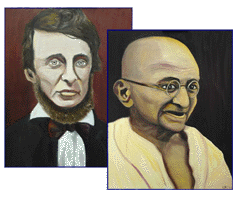"The whole aim of practical politics is to keep the populace alarmed (and hence clamorous to be led to safety) by menacing it with an endless series of hobgoblins, all of them imaginary." ~ H.L. Mencken
Gods & Generals--and Memories
 On Veteran's Day I slept in the Confederate trenches at Fredericksburg battlefield. As an old vet, I felt it was fitting. That night the autumn leaves rustled under my sleeping bag and I lay awake for a long time in the forest of hundred-year old trees, trying to make some sense of a senseless conflict.
On Veteran's Day I slept in the Confederate trenches at Fredericksburg battlefield. As an old vet, I felt it was fitting. That night the autumn leaves rustled under my sleeping bag and I lay awake for a long time in the forest of hundred-year old trees, trying to make some sense of a senseless conflict.
Then as now, the night was cold, 26 degrees, and darkness came early, as it did so long ago. In December 1862, two powerful forces clashed here along the Rappahannock River in one of the bloodiest battles of the Civil War. For weeks the Army of the Potomac had massed 120,000 troops above Falmouth, Virginia, while General Burnside awaited the pontoon bridges that would take his army across the river to smash the 70,000 Confederate troops and the rebellion.
The American republic was scarcely 80 years old, but shells now burst overhead as a squad of Michigan soldiers assaulted the town from clumsy boats. Under fire from rebel snipers, the initial attempt to construct a pontoon bridge opposite the town failed. Given the orders to clear the town of snipers, Union artillery'between 100-150 cannons on Stafford Heights-- smashed the colonial buildings and set historic houses afire. House-to-house fighting lasted until nightfall before rebel sharpshooters withdrew. That night, gangs of Union soldiers filed across the bridges and looted and torched houses that had once hosted such presidents as Washington, Jefferson and Monroe, houses that once resonated with lofty ideas and humane principles but which now burned in a bacchanal of destruction. Less than a mile downstream from the burning town, some 40,000 Union soldiers massed for a battle that would occur the following day. They stepped out smartly from the pontoon bridges that spanned the Rappahannock River and formed up in ranks, having crossed the river from Ferry Farm'the boyhood home of George Washington.
Soldiers sometimes share more in common with those they fight--with the warriors of the so-called enemy--than with thosewho send them out to die. Robert E. Lee, once superintendent of West Point , previously chosen by Lincoln to lead the Union army, (which he rejected) now opposed many of his former students on this battlefield. Defending the well-fortified heights to the west, Lee could only shake his head at the carnage. 'It is well that war is so terrible,' he said, 'We should grow fond of it.' In 1862, the trenches around Fredericksburg stretched seven miles. The bombardments, suicidal assaults, house-to-house fighting, and trench warfare seemed a precursor to the modern warfare that followed throughout the Twentieth Century. Indeed, General Burnside's battle strategy seemed a tragic blueprint for the two World Wars to come: the muddy squalor, the amphibious landings, the bombardments of civilian towns and, finally, the squandering of lives in suicidal charges with fixed bayonets, while the architects of war remained far from the front in distant capitols.
At Fredericksburg that day, Lt. Henry Curren wrote, "The slaughter is terrible; the results disastrous." I was startled awake that night in the woods as I slept on a cushion of fallen leaves, half-convinced a squad of soldiers rustled past me, but when I looked for ghosts in the mist, I saw only a single whitetail deer. Wouldn't it be fitting, I thought as I huddled deeper in my sleeping bag, to require all the world's leaders to spend a cold night together in the trenches of a long-ago battle? A veteran soldier who becomes a statesman does not casually send men out to die, knowing full well, if he is wise, the fear of death and the aversion to killing he too once felt on the battlefield. Not surprisingly, for 50 years after the Civil War, Americans tended to become isolationist, almost pacifistic, having witnessed or participated in the carnage and destruction and, yes, the folly of what happened in places like Fredericksburg , Virginia 140 years ago. For here at Fredericksburg , on a single cold and dismal day, over 18,000 casualties were inflicted, more than twice those suffered on D-Day at Normandy ; more than four times the casualties of Pearl Harbor . The Union soldiers fought bravely here but the Confederate troops held the high ground. Massing four deep behind a stone wall on Marye's Heights'not far from downtown Fredericksburg --the soldiers of Cobb's Brigade slaughtered the Union soldiers who rushed the summit. In one hour the Army of the Potomac lost 3,000 men assaulting the impregnable wall fronting a sunken road. That night many of the wounded men, limbs shattered, lay on the open field and froze to death. In the velvety darkness, hushed of gunfire at last, the Northern Lights shimmered and danced overhead with iridescent colors seldom seen this far south. To the dying soldiers staring at the sky, this pale luminescence like a sign from God--so frightening, mysterious or oddly comforting--was the last thing most of them would ever see.
You can walk through history in Fredericksburg , probably better than any other American town, and stare at the buildings where our first statesmen stood'the very same buildings Civil War soldiers cowered behind. Only an hour from Washington, D.C. , Fredericksburg has a sort of suspended-historical feeling about it: the Rappahannock River meanders through town bowered by overhanging trees much the same way it did in 1862; brick buildings appear much the same and cemeteries scattered among picket-fenced lawns commemorate Union and Confederate dead. Locals tell of sighting ghosts, and I do not doubt them; one bartender remarked to me that not one but two ghosts inhabited a popular Old Town establishment. Walking around on chilly nights, I imagined the spirits of soldiers and statesmen hovering in the haunted streets of Fredericksburg , reminding anyone who cared to heed them of the wisdom of reconciliation and the folly of war.
But history has a way of biting us when we turn our back on it. I cannot see Rumsfeld or Limbaugh quietly reflecting on war; rather war is an easy decision for our statesmen simply because few have witnessed it and fewer heed the lessons to be learned. One local historian remarked, 'The battle of Fredericksburg , although profoundly discouraging to Union soldiers and the Northern populace, made no decisive impact on the war.' If nothing else, Fredericksburg serves as a permanent reminder of government folly and the cynical squandering of human life, thirty minutes from the corridors of power in Washington , D.C . Did these soldiers die in vain, I wondered?
At Kenmore , the stately mansion built by Fielding Lewis, Washington 's brother-in-law, you can see still a Civil War era cannonball protruding from the outer brickwork. A rifle was found in the rafters during a recent restoration, the weapon possibly belonging to one of the Confederate snipers who opposed the advancing Union army. George Washington slept here, and I distinctly heard a ghostly creak when I lingered for a moment in the furnished guest room. Kenmore mansion later served as a hospital for Union soldiers, wounded during the Battle of the Wilderness. While wandering through the grand salon of Kenmore --called one of the most ornate rooms in America --I tried to imagine the tragedy that occurred here in this dining room long ago. The salon served as a makeshift surgery during the war, and I envisioned delirious soldiers staring upward at the arabesque designs in the ornate stucco ceiling with morphine scarcely numbing their pain. What a confusion of disturbed thought'hope and despair--must have flooded their minds. They had lost their arms and legs forever for the simple failure of leaders to lead. Even during the worst killing on Marye's Heights, some soldiers realized this. 'All that day we watched the fruitless charges, with their fearful slaughter, until we were sick at heart,' said Confederate Private Alexander Hunt of the 17th Georgia , gazing down at the dying Union soldiers. 'As I watched one line get swept away by one fearful blast from Kershaw's men behind the wall, I forgot they were enemies and only remembered they were men, and it is hard to see in cold blood, brave men die.' December 2002 marks the 140 year anniversary of the Battle of Fredericksburg.








 Reprint Rights
Reprint Rights